Research
Primary and Secondary Research
Primary research is 'raw data'. A source of original data that we collect to be analysed in relation for our products. We use primary data to improve accuracy of our research and also gain further knowledge on our topic, it can also be more reliable than secondary data to our specific topic and up to date. Some examples of primary data to conduct are: interviews, vox-pops, questionnaires/surveys, control groups. All of which relate by getting people's opinions and sourcing facts from professionals and individuals in the fields. Primary research will help my documentary as when discussing the impacts of natural disasters on people, to gather opinions and statistics from people who have witnessed first-hand and meet them can elevate my product authenticity and having that powerful impact on my audience.
Secondary research is sources of data that have been gathered and analysed for us to further analyse within our products. We use primary data to gather data and information quickly with reliability. We are assured that the data has been checked and it can have been gathered on a vaster sample base than what we can get in our time from and capabilities to broaden the spectrum of our findings and research in our argument points across our product. Some examples of secondary data available are: censuses, government publications, websites, books, journal articles. All of which can be conducted by a wide variety of people such as journalists, scientists, politicians and so much more. Secondary research will help my documentary as when delivering facts from natural disasters from across the world, it will be useful to have the statistics co-ordinated from each place of origin to compare and contrast and which will showcase the true impact and scale of the reality of my discussion.
Quantitative and Qualitative Data
Qualitative data is descriptive data that can't be easily represented as numbers. We use it to understand why, how and what happened behind certain behaviours. Qualitative data can be collected in a range of ways such as interviews, open-ended forms and group observations and often analysed and publish on websites, case studies, and textual sources such as books and articles. They are good for collecting opinions and feelings and descriptions to what you are discussing for further analysation. I can use this in my FEP to create a personal touch with my audience, watching a documentary and engaging with a documentary are entirely different things and to get my audience to engage, I can use qualitative data to get opinions and feelings from people like my target audience so that it demonstrates how impactful this project is to everyone's lives. Additionally, for my research, it will give broader perspectives on the narrative I'm hoping to achieve than just my own and help me gauge what people want to see and hear more/less about and understand what I can do to make this project about the people as well as the nature.
Research Planning
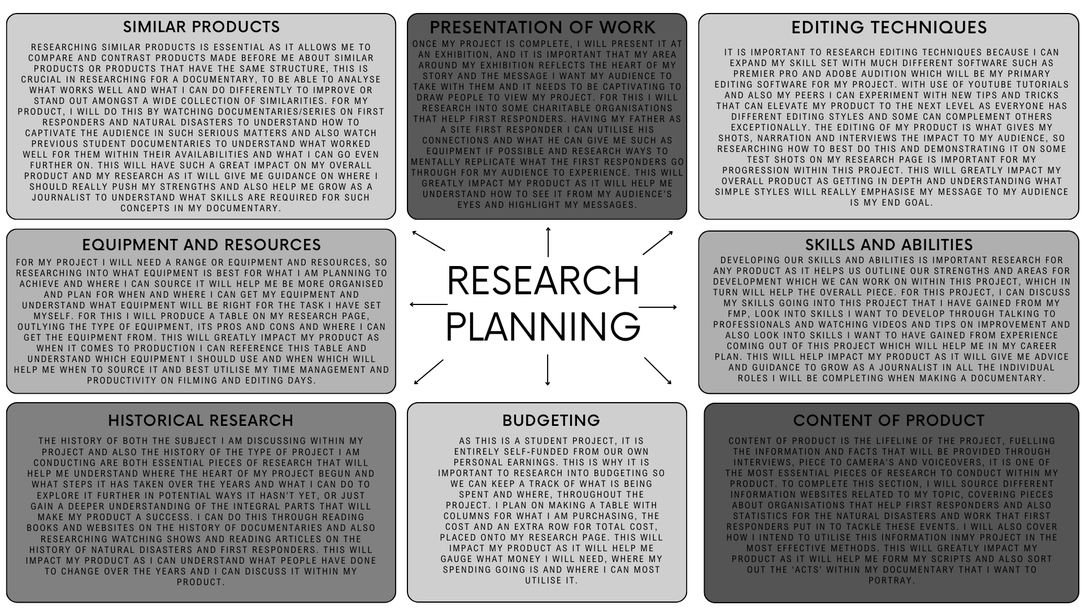
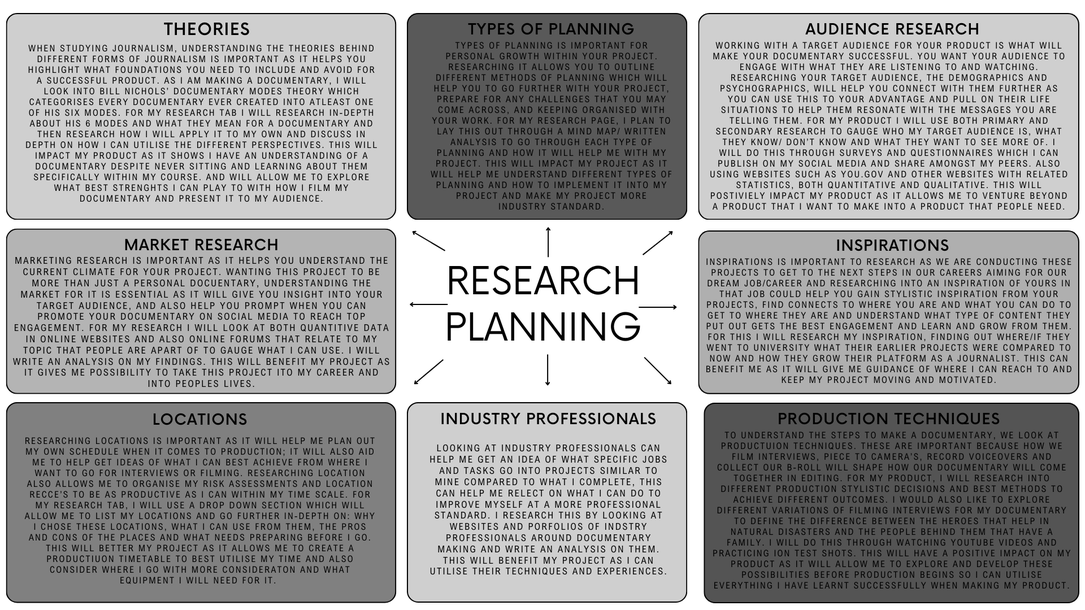
Similar Products
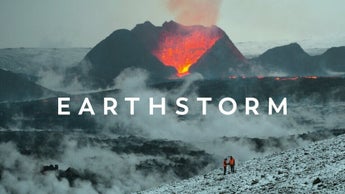
Netflix (2022). Earthstorm | Official Trailer | Netflix. [online] YouTube.
Available at: https://www.youtube.com/watch?v=ALFt3mbUWKk [Accessed 27 Jan. 2025].

News, C. (2021). ‘Bring Your Own Brigade’. [online] Cbsnews.com.
Available at: https://www.cbsnews.com/video/bring-your-own-brigade/.
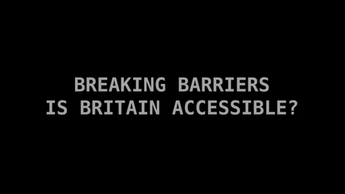
Charlotte Pearce (2024). Breaking Barriers: Is Britain Accessible. [online]
YouTube. Available at: https://www.youtube.com/watch?v=xEzsOAd4a7g [Accessed 27 Jan. 2025].
The first product I watched was a documentary series on Netflix called Earthstorm. I chose this series as it follows a different major natural disaster each episode and gives real and raw personal footage into the reality of these situations whilst also educating the audience about these events. For my documentary, I am tackling a subject I have never done before, so watching a product on the same/similar topic will broaden my knowledge on how to structure my documentary and how to achieve the emotional atmosphere of this type of product.
Similarly, the second product I have chosen to watch is a two hour documentary called Bring Your Own Brigade (BYOB). Like the first product, this one focuses on natural disasters but it zones into one specific disaster, wildfires. I felt this is an important documentary to engage with, as for my documentary I will be working closely with firemen who have the most experience with this category of disasters, so this product can give me an insight into what first-responders have to do to tackle these situations. Likewise with Earthstorm, BYOB uses personal and raw footage and interviews the victims of these events but in contrast to Earthstorm, BYOB is calling for a change in how people fight these situations, taking a look into private VS public fire departments and whether this system is beneficial to the country or just to the departments pockets.
Following on with that theme, the third product I watched was Breaking Barriers: Is Britain Accessible? (BB). Just as BYOB is created to inspire change in society, Breaking Barriers is on the same mission, looking at where the UK is lacking in support for people with disabilities and their ability to live their life as normal and as independent as they can, this documentary gives me a more exclusive look on the potential my product can have as BB is also a student-made product by my friend Charlotte Pearce when she completed her FEP and graded a distinction for her product.
All three products have pros and cons and use similar and different ways to convey their message in a successful and empowering way. One area that we see this, is the first 30 seconds. In my opinion, the first 30 seconds is a pivotal moment for a documentaries success as whether it catches your audiences attention depends on that time frame before they click on to something else. Earthstorm opens with flashing scenes of home footage in the height of the action of the natural disaster they are covering. Despite me thinking this is a very cliché way to begin this type of product, I do believe it is effective. In contrast, BB opens with a segment of a well known public figure making a powerful and inspiring statement to kickstart what journey this documentary will take you on, I think the added aspect of it being shot through train doors which aren't accessible to wheelchair users 100% of the time gives it a powerful incentive to continue watching and although this is borrowed footage, the placement of it at the start is what creates the powerful effect. In some way BYOB is similar as it begins with an interview but instead of a powerful statement, BYOB brings a more emotional atmosphere with a hint of positivity as we follow through a persons garden looking at what the wildfire destroyed but also reflecting on all the fruit and vegetables that stayed safe. In my opinion, I find this opening to be the most impactful as the name of the documentary hints to what it is about and you create the anticipation to see the fire, similarly to how Earthstorm opens, but your greeted by an elderly gentleman, therefore your guards are lowered and you feel that emotional pull from the start. in my documentary, I would like to draw aspects of all three of these products into my opening to catch my audiences attention and keep them engaged.
Each product has very strong qualities that I can reflect and utilise in my own product. BYOB does a great job of showcasing and representing these devastating events and using interviewees to tell their personal stories and experiences throughout rather than a narrator/presenter taking centre stage. This documentary structures its interviews to work in unison to paint a big picture and take the audiences on a journey. This can be useful for me to replicate in my own product as it makes the viewing more smooth which allows for the viewer to take in more information and act on it and has a very empowering effect as we see the cameras angle being the one to provide support and assurance. In comparison, Earthstorm is a good example of how to use footage from these real situations and edit them with audio, music and more to create an emotional and dramatic effect to tell their stories. Since it is primarily consisted of home footage shot on victims phones that they have captured in a hurry, the editing team of Earthstorm as sequenced it and added audio layers on to it to give the audience a more cinematic feel and to show how this story played out through the eyes of those within it, this creates a powerful effect of escapism to the viewer as they feel like they have been through it themselves and can engage with more emotion and sympathy towards the product. In contrast to the first two, BB shows me how to play to the strengths of a student documentary compared to one with a large budget and a big team of professionals. Due to student limitations both BB and mine will feature online interviews over sources such as Microsoft Teams, these aren’t commonly seen in documentaries but can be seen on news shows such as BBC Breakfast as they interview people around the world. So utilising Charlotte’s product I can see and learn how to best incorporate these online videos to still get that authentic, professional feel.
As I am aspiring to be a presenter and therefore will be featuring in my own products to demonstrate this through my piece to cameras, it is good to reflect on these similar products on how they conduct this. BB goes for a similar style I am hoping to portray in using both piece to cameras to invite the audiences to join you on the journey of the documentary and also voiceovers to continue to be that guiding voice whilst taking them on a visual journey. Since BB achieved top grade through its examination, it is good for me to analyse and self-reflect on their presenting skills to see where I can develop mine further and how to use piece to cameras at the right time within the product to get the most smooth engagement. In contrast, Earthstorm uses only voiceover narration in their episodes which reflects an almost god-like guidance through the stories they are displaying. Despite not having any physical narrator, this is a good chance for me to reflect on how they edit their voiceovers and the music and sounds they accompany with them for my own project to get that professional feeling. In addition, looking at how they balance narration and interviews is a good way to reflect on the balance that would work best within my own product, especially as we are discussing similar events. Unlike BB and Earthstorm, BYOB doesn’t follow any narrator, instead it is structured like the audience is the silent witness, listening to the interviewee’s stories as they play out. With combinations of interviewees and also events that relate such as scenes of community meetings taking place to address the issues discussed, BYOB manages to portray strong emotion with no ‘professional’ input. This is a good technique for me to learn and adapt from as when discussing such devastating instances, sometimes the silence and facial expressions speak louder than words.
Such as analysing the opening sequence is important, the ending is equally if not more impactful to our audiences. Where the opening is what draws them in to engage with your product, the ending if what they are left remembering and acting upon within their lives. All three products do this in a different and unique way but all have an incredible lasting effect. Earthstorm closes each episode with a speech from the narrator about the fact that nature has a mind of its own and it is better for us as humanity to grow and accept that it has been that way since the start of time and will continue to be that way, coupled with peaceful oceanic shots which contrast to the destruction panic shots that it opened with to symbolise coming to peace with natures doings. This is incredibly powerful as the shots have a calming effect on the viewer and allows them to take on the message in the speech and change their outlook on such situations. In contrast, Bring Your own Brigade apart the narrator voice to discuss in a short sentence the work that needs to be done to improve people’s lives and then accompanied with soft music, has each interviewee and person featured in the documentary give their feedback on work that needs to be done for everyone’s safety. Unlike Earthstorm, this gives a more unresolved emotional feeling to the audience to influence them to act upon it themselves to make a resolution. This is powerful as it though provokes the viewer time and time again after the documentary has ended and helps change the mindset of society to be better. Similarly, Breaking Barriers uses a slowed down approach with soft music, but in a more unique style, it ends on a piece to camera speech discussing how far the world has come but how there’s still a way left to go, this has a similar effect to BYOB as it ends, though provokingly to the audience to inspire change across the UK but with use of direct address, it has a more personal connected feel as she address the audience themselves. All three products conclude in a powerful way and I will strive to use small aspects of each within my own product.
Overall, this research really benefits my product as it allows me to take the time to analyse the components that go into such products to make them what they are and then reflect upon mine and be inspired by and utilise to have the same or similar outcome.
Content of Product
Introduction
For my Introduction, I want to capture my audiences emotion within a short time frame - such as 30 seconds - as it will have a cliff-hanging effect on their mood and curiosity and in turn make them delve deeper into the atmosphere I am creating.
Using contrasting shots appearing after another keeps my audience on the edge of their seat as each clip is a story not completely told, that the human mind seeks answers to. In addition, using instrumental music that you expect to hear on a wildlife documentary such as 'The Blue Planet' by Sir David Attenborough, that everyone knows and recognises in their subconscious linked to our planet with the plants and animals, brings a sense worry to their safety without ever being shown it.
My first piece to camera will open with a statistic or fact which will have my audience initially questioning what they know about the subject and push them to continue to watch to further inform themselves. Using a fact as small as "There are 10 types of natural disasters that strike our world", instantaneously has my audience counting the ones they recollect and further invites them to seek the ones they can't remember, therefore, engaging them in my product.
- earthhow (2023). 10 Types of Natural Disasters. [online] Earth How. Available at: https://earthhow.com/natural-disasters-types/.
Similarly, to introduce the idea of 'dual identity' within my project, using a well known superhero such as superman as comparison to our first responders, creates an open minded approach to how our emergency workers are represented and provokes the thought to my audience on whether they do know their real life heroes as they do their fiction ones.
Act One
Opening with an interview from the point of view of a first responder about public misconceptions, shows to my audiences that this isn't something I, the narrator, has just researched and is informing you of, but it is coming from the heart of the subject, creating further engagement between the 'hero' and the family guy.
Similarly having shots of their training - especially POV body camera shots - puts my audience in their shoes and how they experience day to day life to ensure they are their most capable for when we need them. Plus, having emotional music behind the shots makes my audience's minds feel more emotionally relaxed to take in the information given.
Continuing on, using a perspective from across the world brings that sense of unity that we all share in these darker moments in life. As well, contrasting on the well known stereotype that Australia is known for its wildfires and discussing the floods they experience as well, which aren't as well broadcast in the media, gives a progressive outlook to my audience to take away from this documentary and look further into the topic to understand more.
Lastly in act one, having a piece to camera on location for an area local and frequent to wildfires in the UK, brings home this almost foreign idea of natural disasters in our area as they aren't typically portrayed in the media due to their smaller scale. It also showcases to my audience about how easy these types of disasters are caused and how dangerous they can get to our first responders in such a short amount of time.
- Phillips, H. (2025). Marsden Moor wildfire damaged 14,000 new trees. BBC News. [online] 29 Apr. Available at: https://www.bbc.co.uk/news/articles/cgqvjw4qqjzo.
- Wilkinson, D. and PA, T.H. (2025). It’s only April, but 2025 is already the UK’s second worst year on record for wildfires. [online] Manchester Evening News. Available at: https://www.manchestereveningnews.co.uk/news/greater-manchester-news/its-only-april-2025-already-31439457 [Accessed 13 May 2025].
Plus, discussing the more scientific effects creates a greater sense of danger and emergency to the audiences perspective when contrasting the long term effects in the UK's beautiful moorland.
- Farmer, A. (2025). Moorland fires having ‘serious impact’ on wildlife. BBC News. [online] 7 Apr. Available at: https://www.bbc.co.uk/news/articles/c5y6ey7x6nro.
Act Two
In act two, I decided to showcase the work that people like my audience and volunteers do to help relieve the strain on first responders and the victims of these disasters. I followed the story of Reach Out Worldwide as I think it does an amazing job of displaying what people can do with incredible compassion and any resources they can find, plus furthering on the 'hero' outlook by discussing the founder to be Paul Walker, beloved to many as Brian O'Conner who built something from the sense of his compassion. And utilising the footage they have created to give another point of view to my project, enhancing the engagement and unity feel to my audience.
- Youtu.be. (2025). Available at: https://youtu.be/YpZAbNXV0fs?si=dHoLF-hpDcMfGElw [Accessed 13 May 2025].
- Youtu.be. (2025). YouTube. [online] Available at: https://youtu.be/FxU4kDmRzIw?si=rowI7euyYq-MAIrB [Accessed 13 May 2025].
Showing the statistics of the work the volunteers do as on-screen graphics gives my audience time to slow down and really take in the information provided to give them an accomplished feel and also a potential desire to contribute to help what has been discussed throughout my project.
-
Instagram.com. (2025). Reach Out WorldWide (@reachoutww) • Instagram photos and videos. [online] Available at: https://www.instagram.com/reachoutww?utm_source=ig_web_button_share_sheet&igsh=ZDNlZDc0MzIxNw==[Accessed 13 May 2025].
Act Three
For my final act, I wanted to delve into the mental health support for our first responders as we discuss the traumatic sights and events they have to shoulder. For this, telling the perspective through interviews from mental health specialists and the first responders over a script and voiceover gives a more authentic in depth atmosphere to the project.
-
March On Stress (2012). March On Stress >> Trauma Risk Management (TRiM). [online] www.marchonstress.com. Available at: https://www.marchonstress.com/page/p/trim.
-
NHS Barnsley Talking Therapies. (n.d.). NHS Barnsley Talking Therapies | South West Yorkshire Partnership NHS Foundation Trust. [online] Available at: https://barnsley-talkingtherapies.nhs.uk/.
Outro
For my outro, I feel ending on a piece to camera and personally thanking our first responders but also my audience, solidifies that unit feel between me the filmmaker, the first responders as the heroes and the audience who will take away from this project and using the zoom out into the globe shows that through symbolism.
In addition, showing the "bloopers" of my documentary alongside the credits really shows the less serious side of our first responders and how friendly and approachable they are. Creating a stark contrast from the first shot of them running into the truck with the alarms in 'work mode' to them having a laugh and enjoying some cake brings to a perfect close, the look of the 'dual identity' as we went on a journey to get to know them through the whole project. And through the use of the song 'I Won't Give Up' by Jason Mraz, I think it captures the emotion of the project, seeing it out and really represents the mindset of our first responders who fight for us.
- Youtu.be. (2025). Available at: https://youtu.be/O1-4u9W-bns?si=-zK_WisBRL2OZZiv [Accessed 13 May 2025].
Overall, researching into the content of my product is vital to understand the way that my audience will perceive my narrative and be influenced and engage with my product.
Despite having less factual content to my last products such as my FMP documentary, I think it is just as powerful as it is more interview-lead rather than the interviews supporting me and it takes my audience on a more prominent emotional journey rather than an educational journey. Having my documentary analysed allows me to better distinguish limitations, further possibilities and whether I am achieving my goals that I am setting out to get. And having the ability to research this through the different stages of my product all the way through post-production and making continuous edits allows me to see it at full focus in the end.
Historical Research
"While the term 'first responder' only started coming around in the 70's, the concept has been around since Ancient Rome, when Nero created the Vigiles, the first public firefighters" - AFBA
admin-afba (2023). The history of the first responder. [online] AFBA. Available at: https://www.afba.com/uncategorized/the-history-of-the-first-responder/.
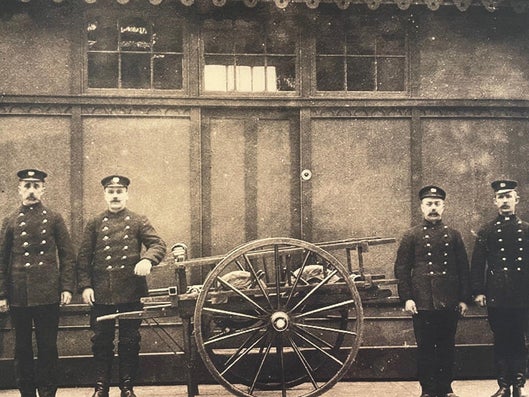
City of Edinburgh Council. Created by Eskimo, Pooka and Edinburgh Libraries. (2025). Edinburgh First Fire Brigade. Available at: https://www.ourtownstories.co.uk/story/902-a-history-of-fire-fighting [Accessed 2025].
Natural Disasters
When looking at some of the biggest natural disasters in history, stereotypically, the mind wanders to the eruption of Mount Vesuvius in Pompei in 79 AD which was a devasting event that took the lives of the people in the village, perfectly encasing their bodies. And it has been studied for centuries up into modern day. But there are many natural disasters that aren't as well known. In 1815 Mount Tambora in Indonesia erupted marking itself as the largest volcanic eruption in history with 36 cubic miles of rock into the atmosphere and ash which could be seen up to 808 miles away. But when we think of more modern day natural disasters, the mind wanders to wildfires. Events such as the Australia Wildfires in 2019-2020 where South-eastern Australia experienced horrific wildfires that burned approximately 46 million acres of forest, 33 fire related deaths, 445 smoke inhalation deaths and 4,000 smoke related hospitalisations. And the facts behind the frequency of wildfires are heavily man-made. Due to global warming, it is very publicised that our summers are getting hotter every year with the intervention of heat waves. Therefore droughts drying our grassland, accompanied with man made objects such as broken glass bottles, BBQ's are rapidly increasing the rate of wildfires across the world.
The impacts of this has meant that certain fire prone areas are developing wildfire watch groups and emergency services have their own wildfire prevention teams that work around the clock to try and make our world more safer.
This research greatly impacts my products as it allows me to understand how natural disasters have developed overtime so when I tell my own facts and statistics within my documentary I am more informed to tell my viewers. It also gives me more direction to help improve my content of product for my documentary.
- WMO (2021). Weather-related disasters increase over past 50 years, causing more damage but fewer deaths. [online] World Meteorological Organization. Available at: https://wmo.int/media/news/weather-related-disasters-increase-over-past-50-years-causing-more-damage-fewer-deaths.
Fire and Rescue
In the early 1800's houses were still primarily made of wood and built close together, plus open fires were still the primary use of food, hot water, and other daily activities. Due to this horrifying fires were a popular occurrence and there was no solid fire tackling system put in place. Typically insurance companies would hire their own men to respond to these issues but it would often lead to debates and competition over resources such as buckets and water.
This is when in 1824 during the peak of significant fires including the Great Fire of Edinburgh and the death toll rising, the city established the Edinburgh Fire Engine Establishment which would be come to be known as the worlds first municipal fire brigade. This brigade was led by James Braidwood who was just 23 working as a surveyor and in history labelled the "father of modern fire service". It was Braidwood who spent his life implementing training, equipment and requirements including Scotland's first fire engine. He built up his team of tradesmen who were familiar with building structures such as carpenters, slaters and masons typically aged between 17 and 25. Towards the end of Braidwood's career, he wrote a book about his methods, requirements and training to be shared across the world and his legacy is still shared today every year in Edinburgh
This research, I believe, is crucial to my product as it allows me to understand the systems we have in place for modern day firemen and how they all came to be. it also allows me to understand the importance of our first responders through history and will influence how I can interview the firemen in my documentary surrounding this.
- Kinniburgh, M. (2024). How Edinburgh created the world’s first fire brigade. BBC News. [online] 21 Oct. Available at https://www.bbc.co.uk/news/articles/cje3p70pl7zo.
British Red Cross
Starting in 1863, a Swiss businessman, Henry Dunant saw the suffering of thousands of men on both sides of the Battle of Solferino where many men were left to die due to a lack of care. In response he proposed making national relief societies where volunteers who were trained in peacetime would provide impartial help to suffering during the war, this was to become the International Red Cross and Crescent Movement.
As the Movement continued to grow, gaining a committee in Geneva, years later war broke out between France and Prussia in July 1870 and Colonel Loyd-Lindsay called for a National Society to be formed in Britain. The British National Society for Aid to the Sick and Wounded in War was formed. It helped both armies during the Franco-Prussian War and was Renamed the British Red Cross and by 1908 King Edward VII gave it its first Royal Charter.
Today the British Red Cross helps out in many ways, providing aid through food, water, shelter and supplies for many causes worldwide such as natural disasters where they travel to provide food parcels and mobile kitchens for people who may have just lost their homes and all their belongings, along with tents and blankets and even cash grants. The Red Cross also have their tracing teams to help victims find their missing loved ones and emotional support workers for people who need it. They are constantly fundraising for donations and volunteers as they continue to aid the world.
This positively impacts my products similarly to the fire brigade historical research. It allows me to understand how far these organisations have developed and come and where they can still go to make progressive steps into the future. It is also good to see how they influence other organisational charities to adapt themselves.
Red Cross (2017). The Origins of the Red Cross | British Red Cross. [online] British Red Cross. Available at: https://www.redcross.org.uk/about-us/our-history/movement-origin.
History of Documentaries
Documentaries have been around for over 120 years but the meaning behind the word 'Documentary' and the usage of the phrase has changed forms over the years.
In the earlier forms of documentaries, they were made known, mostly, by the Lumiere Brothers names Auguste and Louis. They would create short 60 second clips of boats and trains arriving at their ports/stations. These were seen as incredible forms of education, escapism and more. Following the Lumiere Brothers the term was next adopted by John Grierson in the early 1920's. The Scottish filmmaker saw the potential for usage of film to be used to document someone's life and big political events which would often get miss-told.
Soon after this travelogue films rose in popularity dominating the 'documentary world' which despite the lack of audio, these films allowed people to seek escapism and education on cultures around the world. This is where documentaries made their biggest leap going from 60 second clips from the Lumiere Brother to 80 minute long films.
if one was to research the first ever documentary - as what we know it to be - there are many opinions and views on this but the most popular is 'Nanook of the North' by Robert J Flaherty showing the culture of his home town Nanook and life as an Eskimo. This documentary sparked worldwide debate on the supposedly "staged scenes" and this is when the firs rendition of codes and conventions for a documentary were discussed.
Similar to films, documentaries took on their own selection of audience categories as we began to see the sports and homelife genres emerging and altering the marketing for such documentaries. But everything took a 180 flip during World War II, during darker times for people at home many people across the world turned to cinematography for a distraction, a form of escapism and to bring hope and light to peoples days. But as the revenue from movies and documentaries grew, governments began to take notice and this is when the age of propaganda documentaries began. This worked well for governments to indoctrinate people as the stereotypical documentary showed the life of other cultures, therefore it was more easier to spin the real intentions of other cultures around the world.
But in modern day, we see documentaries and movies merging together as we get re-enactments to tell the narrative you would in your documentary but with more atmosphere. A good example of this would be the Netflix series 'Baby Reindeer' by Richard Gadd which told his story through re-enactment as though the audience was experiencing it with him. Documentaries continue to grow in popularity - especially during COVID-19 when people were isolated in their homes - with crime documentaries being very successful.
Theories
D O C U M E N T A R Y • M O D E S
The first theory that I have researched and linked to my own product is the Bill Nichols Classification of Documentary Modes theory where in 1991 released his book "Representing Reality: Issues and Concepts in Documentary" where he introduced his theory. Nichols believed that all documentaries were often judged based on how "truthful" or "realistic" they seemed but found this closed minded and limits documentary makers so he developed six "modes" that a documentary can be categorised into where you can ask: How is the truth constructed? What perspective is being shown? and What techniques are used to make us feel or believe something?
In return, this allows documentaries to be viewed by their styles, by the makers perspective, on biased findings, and the reasoning for stylistic choices which both enhances the viewers experience and the filmmakers.
The six modes are:
1. Expository - typically uses direct address to the viewer and archival footage to inform and persuade the audience.
An example would be 'The Blue Planet' by Sir David Attenborough.
This documentary is classed as expository as it has a narrator (Sir David Attenborough) to guide the viewers and inform the audience and uses footage such as ocean life and underwater footage to support his key points and create imagery in the viewers mind.
2. Observational - typically has no narration, seen as 'like a fly on the wall' to present reality as it is.
An example would be 'Hoop Dreams' by Steve James.
This documentary is classed as observational as it follows 2 teens in their goals to become basketball players. The documentary features no commentary, the audience just watch the scenes play out in a raw, intimate way.
3. Participatory - typically as presenter on screen with use of interviews to show an interaction between filmmaker, subject and viewer.
An example would be 'Fahrenheit 9/11' by Michael Moore.
This is classed as participatory as Michael Moore is on-screen throughout exploring the story with the audience and he interviews soldiers and grieving families alongside himself to help shape the story and display his narrative.
4. Reflexive - typically draws attention to the documentaries creation to make the audience aware of the process.
An example would be 'Exit Through the Gift Shop' by Banksy.
This is classed as reflexive because the narrator, Banksy, consistently questions the reality and authenticity of art and film throughout showcasing the behind the scenes of making the documentary and the faults and nuances about the prospect.
5. Performative - typically emphasises the emotional over the physical experience to explore more in depth truths.
An example would be 'The Social Dilemma' by Jeff Orlowski.
This is classed as performative because the documentary uses real personal experiences from interviews to showcase the emotional impact of social media and the behind the scenes of it. In addition it also uses re-enactments to pull on the emotional side of the narrative to the audience.
6. Poetic - typically more abstract to evoke mood or tone rather than argue a point.
An example would be 'My Octopus Teacher' by Pippa Ehrlich and James Reed.
This is classed as poetic because it uses incredible visuals to make the audience feel immersed in the experience and takes the viewer on an emotional journey with the narrator to allow you to have your own thoughts and emotions on the story depicted.
In relation to my own project, I believe that my documentary is a mix of: Participatory, with my use of piece to cameras to connect to my audience as they understand the facts I am displaying and use of my interviews with the professionals my topic is centred around about their own experience so myself and my audience can understand their personal stories more to display the "dual identity" aspect of my project and see the human side to the heroes our media displays. Expository, as I have a structured narrative and display the statistics and information behind the natural disasters of which I talk about which allows me to show a contrast to the personal stories of the first responders where these situations escalate and the dual identity emerges as they leave behind their personal life and emotions to focus on the job at hand. Observational, as I utilise scenes from natural disasters taking place and also scenes of the first responders running in to respond which gives my viewers a first hand view of what happens in these situations.
U S E S • O F • G R A T I F I C A T I O N • T H E O R Y
The third theory I have chosen to research is the Uses of Gratification Theory which came about in response to the Hypodermic Needle Theory which stated that people took in and believed what the media was feeding them. In contrast U&G theory looks into how people are selective of which media they view and absorb based on what fits their perspective, ideologies and personal goals. And over the years people have identified 5 different reasons people are selective over the media they indulge. These are: For Information and Education - where someone will interact with a product to learn and understand more about it, Personal Identity - where someone may see themselves in something or even see a potential role model to follow, Integration and Social Interaction - people who interact with a media product to fit in and bond and discuss with other people about this product ( a good example of this is the release of Baby Reindeer), Entertainment and Escape - people who interact with a product to leave behind themselves in their jobs and home lives and indulge in something thrilling or relaxing, and finally Emotional Release - where people utilise product to process different emotions such as happiness, sadness and grief.
When I apply this to my documentary, you can see how audiences may connect with my product for different reasonings, which I have outlined within my target audience - both primary and secondary. When displaying a story about the dual identity of first responders and how the media portrays them as heroes but they have their home selves too, we can see audiences connecting with my product to learn and understand what our "heroes" go though day to day to be there for us, and other first responders and younger people who wish to be one in the future can connect upon self reflection and also the use of entertainment for people who engage for the natural disaster aspect of the show and the escapism into that world/life.
A G E N D A • S E T T I N G • T H E O R Y
The third documentary theory I have chosen to research with relation to my documentary is the agenda setting theory. First introduced by Maxwell McCombs and Donald Shaw in 1972 when they studied the 1968 U.S. presidential election, this theory explores the idea that the media heavily influences the public on what to think about and how to think about it. It is a powerful tool which the media can use to influence their own agenda for political debates especially.
For example, when relating this back to my documentary, I am showcasing the dual identity of the first responders and directly making the audiences aware of this potential issue to spark public conversation and create a new outlook on our first responders.
In addition, using on screen graphics to highlight statistical numbers and interviews discussing the personal reality, I am making my audience feel sympathy and admiration for everything that our first responders do, on and off work.
Through this, I am taking a more active storytelling technique to shape the public agenda, influencing what my audience talk about at home and potentially what they could debate in political elections when looking for advocacy for mental health.
In my FMP I researched how to make a documentary as I recognised that unlike TV shows and radio shows, were weren't taught how to create one. So for my FEP, I feel researching into theories is a key part in further broaden my understanding of what makes a documentary and the components that go into making an engaging and successful documentary.
Locations
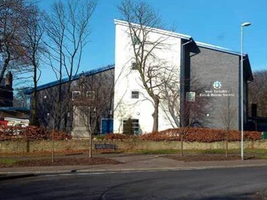
Bing. (2025). New West Yorkshire fire headquarters in Birkenshaw set to get the green ... [online] Available at: https://sl.bing.net/cDfoxADGCYK [Accessed 13 May 2025].
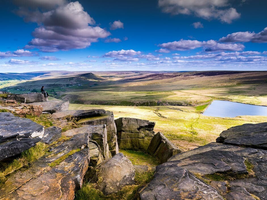
Bing. (2025). Buckstones-Marsden Moor 2: Phil Norton Photography. [online] Available at: https://sl.bing.net/b8YdD1zUitg [Accessed 13 May 2025].
Marsden Moor
One location I plan to utilise for my project is Marsden Moor. This location has been the subject to many wildfires in England and is a great source of B-roll and background for piece to cameras to ensure relevance is kept throughout.
The biggest fire in April 2019 damaged 700 hectares of moorland and took four days to put out. Many first responders ranging from National Trust rangers, West Yorkshire Fire and Rescue, amongst others pulled together to help tackle the fire and it is estimated that it caused £500,000 worth of damage.
In my project, discussing natural disasters that happen overseas creates a challenge for me to collect B-roll and footage within my capabilities but using the stories that Marsden Moor holds, I can discuss and show case the lasting effects of my topic and reflect it onto current events such as the LA wildfires.
Similarly, many of these wildfires being less than 10 years ago in this location makes it a good spot to source interviews from local people to talk about the effects and lasting scars this creates on the community.
*Within the time of doing research and production, this location has had several major wildfires requiring crews from across the UK. This makes this a prime location to get footage to really be within the events.
I want to utilise the moors by being up close with the destructions and showing the stark contrast of before and after.
I will be using a wide variety of all my different pieces of equipment - mainly drone - to get incredible establishing shots, plus shots of myself walking around the moors. And also be filming piece to cameras in this location.
The pros of using this location are that it is relevant to my story whilst providing solutions to challenges I outlined in my context plan and allows me to explore new paths I could take my project that I otherwise couldn’t. Additionally, it is a public place so I will not need to seek filming permission and won’t be constricted to a specified filming day or time.
On the other hand, the cons of using this location is that due to it being a public place there will be a lot of public around that could cause a delay in filming, to overcome this I will have to pay attention to my surroundings and make the public aware of what I am conducting on that day to ensure everyone is comfortable – as well, I will stick to the NUJ codes of conduct when filming in public.
I will carry out a full risk assessment and location recce for this location to ensure that everything and everyone remains safe and potential risks are kept in order.
National Trust. (2025). Marsden Moor | West Yorkshire. [online] Available at: https://www.nationaltrust.org.uk/visit/yorkshire/marsden-moor
Spen Valley Fire and Rescue Service
One location I plan to utilise for my documentary is Birkenshaw Fire and Rescue Station. This location is one of the largest fire stations in Yorkshire and is where crews are sent to do drills and train.
It is a well suited location for me to gain a wide variety of different footage such as piece to cameras, B-roll and Interviews.
Through my contacts I have managed to get access onto this site to be able to come down and film and interview the team there, working closely with the management to organised planned drills that they can set their team on so I can film and get exclusive content understand what they do more closely.
I will be using a variety of equipment listed on my website to ensure I can take full advantage of the access behind the scenes I am gaining.
The pros of this location is that it is exactly what I need to help face problem solving issues with my product surrounding B-roll and interviews and I have an added advantage of getting access to places that others may struggle. Another positive is that as I am also based in West Yorkshire, it is not a long distance to travel, to help save money on budgeting.
The cons of this location is that I will only have one day to get my footage so I need to ensure I plan everything thoroughly and work effeintly on the day to be able to get the most useable B-roll. Similarly, a con to this location is that I will only have a vague idea of what to expect going into this filming day beforehand. With regards to where I will be going, how much the fire station can give me and who I'll be able to speak to will be more determined on the day which can increase the risk for this location for its usability but it will be something I will research and prepare for as much as I can.
I will carry out a full risk assessment and location recce for this location to ensure that everything and everyone remains safe and potential risks are kept in order.
Westyorksfire.gov.uk. (2025). Spen Valley Fire Station | West Yorkshire Fire and Rescue Service. [online] Available at: https://www.westyorksfire.gov.uk/about-us/fire-stations/spen-valley-fire-station [Accessed 7 Mar. 2025].
Industry Professionals
Lucy Walker
.

Lucy Walker is a Emmy-winning, twice Oscar-nominated, English Director who is known for making many Documentaries such as 'Bring Your Own Brigade', 'Countdown to Zero' and 'The Crash Reel' and many more. She began her career early after graduating from Oxford University and getting a full scholarship to study film at NYU's Tisch School of the Arts where she earned an MFA and directed award winning short-films before entering documentary making.
Lucy Walker created 'Bring Your Own Brigade' a documentary analysed in my similar products detailing similar events as to what I am planning to discuss in my own documentary. Her story-telling was raw to not take away from the personal experience of all the victims of the wildfires she spoke to but pulled out such emotion from the viewer and executed real problems within the documentary smoothly without taking away from the emotional pull and I want to mirror this within my own product.
This section of research really impacted my product as I am making a similar product to Lucy Walker's and speaking to her gave me the chance to see and understand the person behind the product, beyond that of my similar research section a that will help me understand and learn the skills I need to have to complete my own product and get to her level.
Inspirations
Georgia Cook
For my Inspirations research, I decided to research about Georgia Cook.
Georgia Cook is a Journalist/Reporter working in Boxing who is based in West Yorkshire and began on the same course that I am currently on. Having met Georgia a couple of times and being from the same place and having the same start into the industry as myself, it was fitting for her to be an inspiration of mine as she has made it to the goal where she wants to be and I want to follow in those foot-steps to achieve my goals.
I conducted an interview with Georgia about her career and also her FEP 'Our Angels' about Sans United as she dealt with very emotional and serious topics and I wanted an insight into her tips on how I can do the same for my project.
This research technique helped me a lot, as Georgia is close to my age so I can see in realty where I can go with this project and where I can be as a journalist because I think the fantasy of being a big journalist can sometimes cloud you visions and increase your expectations, so being able to follow Georgia's career and talk to her, gives me real goals that I can look forward to. Plus getting advice from someone who has completed their FEP and got a distinction helps me marginalise where I need to develop myself for this project.
Audience Research
For my target audience, I did research into who my primary audience was but I also did research into my secondary audience as I found they can be the ones to make change with my product so it is important to recognise and utilise that within my project.
Primary Audience
The demographics of my primary audience are a wide variety of people as I am making a product which effects many peoples lives and can intrigue a common interest. I found that the age group of my audience was around 25-55 as they are within the range where they can understand and connect with the themes of family responsibility that I hope to display within my piece when showing the dual personality side of a first-responder. They are also more likely to be set in a career and can understand the pressures of a job and how that can sometimes travel home with you. I also found that this age group are more likely to be drawn by the actions of humanitarian aid and inspired to volunteer or donate much like other charities.
In addition, I found that within my primary audience gender was equal. This can be found as stereotypically, males are more attracted to the high-action aspect of the documentary and the natural disasters whereas on the other hand, females are stereotypically more connected to the themes of family and mental health. I can also boost engagement by discussing females in this predominately male field.
When looking through the scope of social groups, my product primarily lands within middle to upper class. Having that connection with first-responders themselves and also venturing into the world of escapism for others. Plus, people who are more likely to have streaming services to engage in documentaries more often.
The psychographics of my primary audience, I have found are split into four categories.
The first being those who are interest in world affairs and take care into the environment and climate warnings. They will be able to understand the pressures on the first-responders as the frequency of theses events are increasing and will be more intrigued to see the behind the scenes of what the media portrays of our local heroes.
The second being mental health workers and advocates. People who voice for change and volunteer at mental health charities such as Mind or even people who have used such charities before and are inspired by others journeys.
The third being people who are active in their communities whether its participating in local events or voicing opinions and helping out in local councils to better your areas. People who actively want to see change to make situations better and bring a brighter atmosphere.
The fourth being adventure seekers. People such as storm chasers have been rising in popularity where they will actively chase a storm to be within the heart of it and capture footage and readings. They will be able to understand deeply what first-responders have to go through to try and make sure there are no casualties and that people are safe in very intense situations.
Secondary audience
For my secondary audience I found that their demographics and psychographics can be categorised into two.
Firstly, I found that ages 16-18 would engage with my documentary as students who have just left high-school for college and are interested in first-responders as a career path. This product will engage them as it gives them realities beyond the broadcast media portrayal and an understanding of how the teams function. I also found that this audience are more likely to engage with documentaries through advertisement on streaming services and festivals in contrast to my primary audience.
Secondly, I found that policy makers would also be potential secondary audience for my product. They can connect to this product through the themes of lack of workplace help for mental health and the lack of support there for our first responders unless they seek it externally.
First Responders Audience Research
I have conducted a questionnaire with a selected range of audience ranging from 17 to 55 to understand what my target audience understand about my documentary and would want to see from it. This will help me understand where I can educate my audience further on and what small details I can use to ensure it is a product they will engage with.
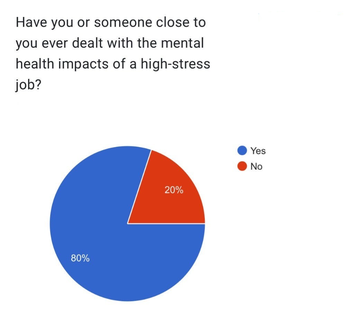

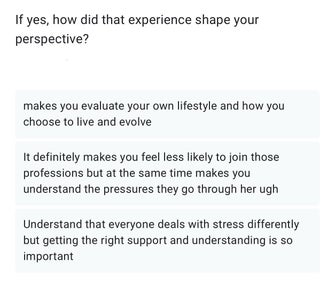
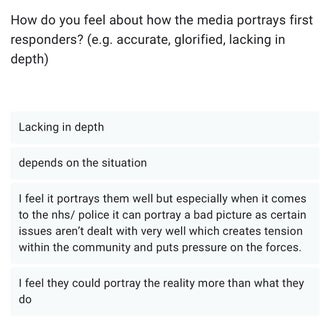
Documentaries Audience Research


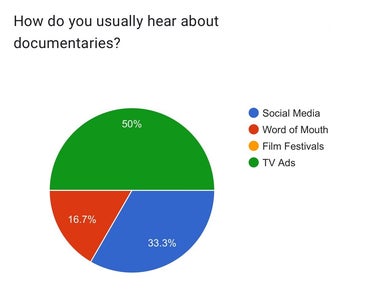
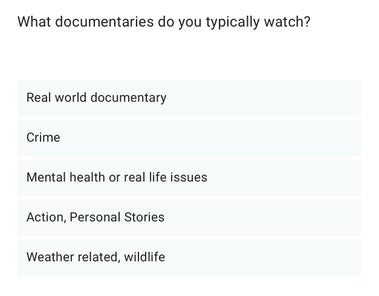
Both questionnaires gave great insight to my product and what I could lean into to increase success rates for my documentary and I plan to take the questionnaire further by demonstrating some of the ideas in test shots and displaying them in a focus group and see if I have the same results when portrayed to them visually.
Types of Planning
Strategic
Strategic planning is the pathway to the goals of my project. It allows me to plan and ensure that my creative visions align with my practical goals to reach maximal potential. I have split my strategic planning into 8 steps: Outlining what I seek to achieve, identifying target audience, creating a narrative, research, collecting resources, build a schedule for production, securing permissions to film, evaluating and setting goals. And planning this out allows me to also plan for errors making my project run smooth.
Operational
In comparison to strategic planning which can be seen as the "what" and "why", operational planning focuses on the "how", "when" and "who" to bring the documentary from paper to life. I hope to achieve this by setting daily goals to keep myself on track and my project moving in an efficient way.
Tactical
Tactical planning allows me to overview my project and what needs to be done and decide what to delegate to when to ensure important tasks are completed within a time frame to keep my project on track and ensure I am not rushing any work and I can keep my best effort in everything I do.
Contingency
Contingency means planning for unexpected outcomes or potential issues that may arise. these could vary from access issues, weather conditions, technical failures or health and safety risks. This is important as it will help me with problem solving and always have a go to backup plan to ensure I don't lose a day of work and can continue with efficient solutions.
This research helps the development of me product as it has allowed me to understand the different methods I can use to keep my project and myself running smoothly and allow me to outline next steps and goals clearly.
Skills and Abilities
Leading Into My Project
When joining my Broadcast Journalism course at Barnsley College, I entered with a basic knowledge of how to use editing softwares such as Adobe Premiere Pro from studying Creative Media at GCSE's, this allowed me to spend more time on refining my skills early within the course and understanding some small tricks to make my editing experience more seamless. In addition, I joined this course with a very outgoing and confident personality which helped me progress my skills in interviewing and presenting very early on.
Through my first and second years on my course, I have learnt and improved my soft and hard skills to make me a promising journalist for my career. For example, problem solving is incredibly important within journalism as you don't always get a second chance, especially when things are live. And with a large use of technical equipment and software, there is plenty of room for error and issues when you become reliant on them. Through my projects on live radio and live TV, I was able to develop my problem solving in a way that masks the problems to my viewer to ensure their experience doesn't falter. As well, learning how to keep myself level-headed and composed to allow myself a clear headspace to think of creative solutions.
As previously mentioned, when joining this course, I entered with a lot of self-confidence which makes for greater creative thinking as I am able to push myself. And whilst being on this course I have been able to develop my confidence so that I can exhume confidence onto my audience through my creations to get more positive feedback.
One last thing that was taught to me on my duration of this course and through my FMP was independence. Being able to have confidence in your skills and know you have had the full support given by peers, tutors and more makes for great independence to go and create your own products with assurance that you can manage and are capable on your own but you still have people around you that you can turn to is important with independence.
Throughout My Project
Through this project, one of the biggest soft skills I am learning to have is trust. When not having control of every part of your project it can create a lot of anxiousness and when the creator is anxious the product reflects that way itself. During this product my biggest challenge is getting my own footage to use, this meant that I have to have trust in my contacts and connections to provide me of what I am envisioning. And having my expectations met and gone above and beyond, is developing my trust skills to as I am allowed to envision things on a bigger scale and take more risky opportunities.
Another skill I am developed further during my FEP is organisation of both physical aspects and mental aspects. This is greatly impacting my product when having perfect systems for my research, my shots, and my schedule to be able to properly analyse where and when I can go and achieve certain goals. This skill will continue to positively impact my product and my career as a journalist.
One hard skill I hope to develop through this project is my evaluating skills. Being able to evaluate where I am and where I am going and what can be adapted is essentials for having a successful product and I am aware it can be sometimes difficult to remove yourself from your environment to properly be able to assess it. The use of peers around me evaluating my product as it goes along can help me improve my abilities in this as I can put myself in their shoes and see my product from a different angle
Equipment and Resources
For this project, I will be using a wide variety of equipment and resources, using what I have to my advantage, to its full potential. And for my research and planning it is important that I outline what I intend to use and how, this is to keep my project organised and running smooth and have a reference to go back to for next steps when I am searching for the right resource for what I am trying to accomplish.
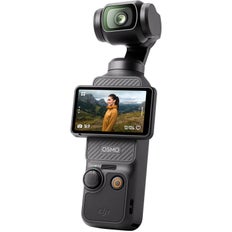
DJI (2019). DJI - The World Leader in Camera Drones/Quadcopters for Aerial Photography. [online] DJI Official. Available at: https://www.dji.com/uk.
For my documentary, I will be gathering B-roll throughout to ensure when it comes to editing I have relevant shots for my script to keep my audience engaged and to keep a flow through my product. Similarly I will be collecting my A-roll - which will be my interviews and piece to cameras - throughout my products as well, these are important as they are the context of the story, they are what the audience is listening to and wanting to learn from. Therefore to gather my visual footage, I will use my DJI Osmo Pocket 3 camera. In comparison to the canon EOS 850D camera I used for my FMP, the Osmo Pocket 3 will be the best option for me to use. In this project I would like to achieve smoother zoom, panning and tracking shots and with the built in gimble and tracking function this camera can get me to those desired outcomes with the best results and coupled with the accessories purchased with the DJI camera such as the tripod and camera effect lenses, I believe I can take my project above and beyond. The Osmo has a lot of features and I intend to watch many tutorials on how to use all of them to my benefit.
When gathering my visuals, for occasions such as collecting piece to camera's or interviews I will use microphones to collect crisp audio and block out surrounding background noise to ensure that the audience are able to pick up and focus on what the speaker is saying and have a more audibly immersive experience with the project which will allow them to take away the desired message more. For this, I will be using my DJI Mic 2's. They are a set of transmitters with a receiver to control audio levels and personal settings for each mic. As well each mic comes with its own windscreen to block out any surrounding noise that may be intruding on the microphones over the speaker. These are great for interviews as they are wireless and discreet and you can control each person's levels from the receiver so that both the interviewee and interviewee are at the same gain. They are also great for tracking shots, being able to magnetise onto the person and connect wirelessly allowing the presenter to talk to the camera whilst moving and not having to concentrate on not moving position of the mic or tangling with the wire to the camera. Similar to the Pocket 3, these mics have their own set of unique capabilities and I will spend the take to research and study up on how to use these to my advantage within this project.

DJI (2019). DJI - The World Leader in Camera Drones/Quadcopters for Aerial Photography. [online] DJI Official. Available at: https://www.dji.com/uk.
Alongside my DJI equipment, I intend to use my PreSonus Audiobox 96 for recording my voiceovers. This piece of equipment is good to use as it is a good microphone in opposed to using a phone device and it is stationed in my house so there are no time restrictions to when I can use this in a case where I may need to edit my script or re-record a part and I can edit the sound files directly to Adobe Audition by connecting the recording suite to my laptop. Some other equipment I will be using will be a cage tripod for my camera to ensure that my shots are steady and level when panning or for setting up my camera for interviews. Around 70% of my shots will be using a tripod as it will look the best. This piece of equipment I can borrow from college by checking it out with out technician. Smaller pieces of equipment I will be using is a USB stick as it is a more secure place to have all my work stored, especially when moving around different classrooms/computers to edit. I will also have a backup USB, having heard from many cases of USB sticks corrupting, I intend to have a backup so that all my work is stored safely in case I encounter this issue. Alongside this I will have an SD card and a Micro SD card for my cameras to film my footage and an SD card reader so I can transfer everything to my USB. All this will be purchased by myself and will be outlined in my budgeting section.
During the course of this project, I purchased further equipment for myself which would enhance my documentary and also my career as a journalist, allowing me to venture further with creativity and move away from stationary camera orientated shots. The main pieces of equipment I have purchased is the DJI Action Camera 4, plus accessories to allow me to utilise the equipment in many different ways and the DJI Mini 4 Pro Drone.

DJI. (2025). DJI Osmo Action 4 - Set the Tone - DJI. [online] Available at: https://www.dji.com/uk/osmo-action-4?site=brandsite&from=insite_search [Accessed 21 Apr. 2025].
I have found, for my documentary, the DJI Osmo Action Camera 4 is a great product to utilise as I can use it for B-roll and piece to cameras that are more active and fast-paced that is not suited for the delicacy of the DJI Osmo Pocket 3 gimbal piece and may struggle. But the Action Camera carries its advantages, especially with the accessories purchased alongside of it such as the chest piece which allows me to get great POV footage which does well on putting yourself into the atmosphere of the footage, car piece which lets me attach the camera to the outer parts of the car and get fast moving travelling footage and extra long extendable hand stick which is great for handheld piece to cameras and also good for getting aerial shots for places that are no fly zones for drones as it can replicate drone footage well.
The camera is palm-sized and lightweight which makes it great to carry on long filming days, films up to 4K with different modes such as slow motion, hyper lapse, time lapse with stabilisation and is waterproof making it great for all different variations of filming atmospheres and locations.
When gathering B-roll in areas such as Marsden Moor when trying to show the gravity of the aftermath of the wildfires, I found that the range of camera footage I can get with a digital camera didn't do the locations justice. So I purchased the DJI Mini 4 Pro drone. This piece of equipment is great for aerial shots of landscapes and establishing shots as well. The drone has great capabilities to do a variety of different fast smooth movements giving me the ability to trial and error many different shot types. I believe the drone has really elevated my project for B-roll and piece to cameras which suits well for discussing global disasters and mass destruction across land. The drone itself is only small which means it stays under the weight limits within the laws which apply to drones and it can film beyond 4K which allows for very clean and crisp footage with many functions within the settings such as slow motion, hyper lapse, time lapse, 360 earth shots and boomerang and much more, plus, it has great stabilisation especially within the moors where winds can be high with little shelter.
The capabilities of the drone are wide and I will take the time to research them to ensure I can get the best of my filming days and also have trial days to test out different shots and which ones would work best and what I can achieve before my major filming days.

DJI. (2025). DJI Mini 4 Pro - Mini to the Max - DJI. [online] Available at: https://www.dji.com/uk/mini-4-pro?site=brandsite&from=insite_search [Accessed 21 Apr. 2025].
Overall, especially in comparison to the equipment I utilised in my FMP, I believe I can achieve new horizons with this project that I couldn't think of achieving are failed to achieve in the past and add more diverse visuals for my audience to remain focused and feel more involved within my documentary.
Production Techniques
Interview Techniques
For production techniques, I wanted to research further into interview techniques. On my course, we are taught how to frame and film a broadside interview for when we made our TV packages which I transferred to my documentary for my FMP, but wanting to develop this I researched different interview techniques and what effect they have and when best they are used so that I can explore that within my project.
I did this through watching a YouTube masterclass on documentaries, specialised in interviews.
- Every (2022). Every Interview Style Explained (A documentary masterclass). [online] YouTube. Available at:https://youtu.be/4E5DkR87SwI?feature=shared[Accessed 10 Feb. 2025].
To analyse this, for primary research, I decided to use a test model and use some different interview techniques using my DJI Osmo Pocket 3 and my DJI Mic 2 to to compare and contrast the different effects so I can analyse and use a variety in my product and ensure the right technique is used for the right situation.
I found that the broadside and the tracking techniques had the most atmosphere to them, especially for my style of product. For my documentary I plan to film my first interview with 2 cameras so that I can have a broadside angle and direct address, therefore I can analyse which has the most emotional effect going forth.
This research will greatly impact my product as I feel the different styles of interviews could potentially take away the "2D effect" of my documentary and make it more dynamic for my audience.
Lighting Techniques
Another aspect of production research I have conducted is looking into lighting. Similar to my FMP, on my course we were never specifically taught about lighting equipment for our projects and for my FMP quiet a lot of my footage was outdoors and interviews done remotely, whereas for my FEP I want to expand my knowledge and capabilities on documentaries and plan to research and utilise different lighting equipment and positionings to enhance my footage and capture more emotion.
To do this, I have watched YouTube videos going in depth on the process you can take and I plan to have a more hands on approach with the staff at my college to understand further with our own equipment.
- Youtu.be. (2025). Available at: https://youtu.be/nqMQZG68Wkc?si=7oLGwWdfjv_3-36y [Accessed 4 Feb. 2025].
- from, L. (2024). Cinematic Interview Lighting: from Basic to Advanced! [online] YouTube. Available at: https://youtu.be/26jrpjwugnI?si=pyVwzFQs7ZwaKeW4 [Accessed 4 Feb. 2025].
Within this, I have found that lightning can have a massive impact on my interviews and piece to cameras as they can create a more dramatic effect and also highlight the facial expressions from my interviewees to my audience. On the other hand, I don't think that lighting equipment will be beneficial for my B-roll as my locations at Marsden Moor will be all outdoors and at the fire station, any shots I get will be in the moment as they are happening rather than set up staged shots.
Opening my Documentary
The way someone engages with a product is determined within the first 10-30 seconds, it is the reason we swipe on social media, its the reason behind the success of TikTok, it is how we as humans are wired. This is why I believe for my production techniques, it is important to research into the opening of my documentary and the different stylistic choices to choose - all of which can have different tones and subjects - which can be the difference between someone walking away from your product and someone getting that hook.
www.youtube.com. (2020). Art of the Opening Scene — How to Start a Movie 6 Different Ways, From Nolan to Baumbach. [online] Available at: https://youtu.be/Jw_ysaoVlt4.
Through this video I can learn what hooks viewers emotionally or intellectually for different atmospheric effects and utilise the examples given to identify different techniques with the visuals, graphics, music and audio that compels my audience to keep watching. It also allows me to understand the difference between chronological and thematic openings where chronological are typically used in historical and biographical documentaries to help establish the sequency early, thematic focuses on big key moments within the documentary grab a hold of my audiences attention.
Overall, this video helps me understand how to hook the audience at the start, the pacing of my opening, methods to use a unique tone whilst avoiding cliches and to clarify my message early.
In comparison to my similar products research, the opening of Earthstorm is faced paced, in the action there and then in a more thematic style, Breaking Barriers uses a more setting context approach with a powerful message at the start to introduce you to the story and journey of the documentary and Bring Your Own Brigade (BYOB) begins with the an interview of the after effects, so polar opposite to Earthstorm despite them being of the same genre. Each is alluring to the audience but I do believe that BYOB has the best approach for my taste as the name of the documentary hints at what the contents is about but the opening contrasts with that which leaves you with more unanswered questions than when you began pushing you to watch further.
Editing Techniques
Researching editing techniques is important as we as journalists aim to make visually stunning pieces of work at professional level, but we are still students learning and there are many techniques and tricks we can utilise that we aren't aware of. To ensure I use my time efficiently, I decided to research editing techniques, on-going with my post-production so I can take the time to trial and error different tricks to create a more visually entertaining piece of work.
One area I decided to research upon was Colour Grading. During my FMP, I primarily used the Canon EOS 180D DSLR that my college supplied and researched how to colour grade and became confident in doing so. But for my FEP I have primarily used higher range equipment which films in different formats and has an overall different visual appearance, therefore, it is essential that I research into colour grading again to get more tips on how to ensure my audience can see the capabilities from what I am filming from.
Youtu.be. (2025). Available at: https://youtu.be/6FHqk0zQR1U?si=0lqY2Hnk6AbDwAzN [Accessed 15 May 2025].
Through this video, I was bale to learn more into what Colour Grading does for a product and each component behind it and learn 3 steps to take footage to the next levels, especially on DJI
Step 1: Base Style Step 2: Sky Step 3: Focus
And understand that each step can be a standalone improvement and make my product exceptional, but combined they bring more out of each other. And utilising this and colour grading my shots on a separate sequence on Premiere Pro, I can cut down on time I had previously spent colour grading each shot and use this method to quickly and seamlessly enhance my footage and place onto my main sequence. This also means I can cut down on time in spending experimenting and researching with different test shot and I can do it directly on my project file without impacting my main sequence.
Alongside Colour grading, I researched into the different transitions you can use within any visual media product and the impact they have on the scene itself and the audience. This is vital within your product as it is the technique that ensures my documentary flows nicely and that there are no cuts and jumps in the middle of an emotion scene, for example, which would take my viewer out of the experience.
Youtu.be. (2025). Available at: https://youtu.be/TKXBAaQB03U?si=ZHMCaUMXKCdesc_v [Accessed 15 May 2025].
This video can help me understand more about editing and production simultaneously as I can begin to picture my own product within this video and how I can frame different shots to lead into others and create an uplifted visual experience. And despite not widely spoken about within this particular video, what I can observe from it is how I can transition between different audio types and use sound samples to create an atmospheric feeling during transitions.
As I am creating a more emotional story for my narrative of my documentary, following tips and tricks often used in cinematic products like described in the video, I can transport my audience to connect and learn from the first-responders I am hoping to portray.
Lastly, as the majoirty of my products audio is recorded on my DJI Mic 2's I researched into removing background noise and editing audio for the few scenes where I am using a phone speaker or platorm such as Microsoft Teams or even a pre-recorded video from a company such as my clips from Reach Out World Wide. This will ensure that everything sounds of the same/similar quality and ensure my viewers aren't having to strain throughout. One area where I vitally needed this research was with my interview with Dave Ramsey as the connection wasn't the strongest being across the other side of the world and our first filming attempts had failed. As a result of this, there was a lot of background noise and Dave's voice lacked clarity. One way i improved this was adding subtitles but I also knew it would benefit from audio editing.
Youtu.be. (2025). Available at: https://youtu.be/qe8vR6jWfeE?si=nxu711NgKCXA1ZXB [Accessed 15 May 2025].
Utilising this video, I was able to understand the techniques within Premiere Pro to improve audio and how best to use them to my advantage. '
These can include the DeNoise effect, DeHummer, DeReverb as the main 3 to use and also the Voice Clarification which targeted the right points that I wanted them to.
Through this I was able to improve the audio for Dave's interview but also the ROWW interview as I found that where they recorded their interview, it was in an echoey reflective room and I was able to improve on this in my own editing session which gave my overall product a more crisp sounding experience.
Overall, with softwares such as Adobe Premiere Pro, there is always new techniques to learn to improve my work, especially as the software grows and updates. Therefore, consistently researching new skills to adapt to my editing and ones which can influence improvement in my production, can greatly improve my product and career as a journalist.
Budgeting
When doing research for a documentary, it is vital to set out a budget plan to ensure that you are remaining smart and tactical for spending money and also allow you to get an overall picture into how much an idea like this would cost and where I could potentially look into money saving options such as purchasing second hand.
| Product | What this is used for | Price |
|---|---|---|
| USB | This will be used to store all of the documents for my website as a secure location incase my websitr was to crash. In addition it will be used to store all my material for production and all my editing files on Premiere Pro. This is useful as it is small and portable meaning I can swap between working on my laptop to working on a computer depending on where I am, for convience. | £15 |
| SD Card | As I have purchased some new filming equipment, it was a smart idea to purchase new SD and Micro SD cards to ensure I can use all my equipment simultaneously. Plus, getting larger GB SD cards so I don't have to worry about running out of storage on filming days like I did during my FMP. I will be purhcasing Sandisk 128GB and 2x Sandisk 256GB. | £14 , £25 , £25 |
| Hard Drive | After filming at my first location, my USB quickly ran out of storage, therefore purchase of a hard drive was necessary to complete my project. | £40 |
| SD Card Reader | Having an SD card reader is important as it will allow me to quickly and efficiently extract footage from my SD cards on to my hard drive. | £6 |
| Food | When going out for long days filming, it is wise to try and set a budget on how much food and drink I will purchase, to keep me mindful of my spending. | £20 |
| Fuel Cost | I will budget for 2 full tanks of fuel for my project to be able to drive to and from my filming locations | £170 |
| DJI Mini 4 Pro Drone | During this project, I experimented with the capabilities of my previous DJI equipment and found them to far surpass any requirements I would need for my project and therefore made the decision to invest in my equipment further and decided to purchase the DJI drone with warranty to be able to take my project to the next level with crisp landscape footage I otherwise would have had to source online. | £1200 |
| DJI Action Camera 4 | During this project, I experimented with the capabilities of my previous DJI equipment and found them to far surpass any requirements I would need for my project and therefore made the decision to invest in my equipment further and decided to purchase the DJI Action Camera 4. After doing extensive research about this product, I found it was graded better than the iconic household name of GoPros and having owned DJI equipment and understand their reliability, this was the perfect piece of equipment for me to purchase for this project. To help with limitating my spending, I looked for 2nd hand cameras and this worked perfectly as I found someone selling one only a year old and only been used once on a motorbike trip so it ws in perfect condition and cheaper than new by £200 and I could pick up rather than pay for postage. | £345 |
| DJI Accessories | After purchasing my DJI Action Camera, I did further research and found an equipment accessories set online with an array of different attachments which gave me incredible capabilities such as: Diving with my camera, attaching it to the exterior of a car, attaching it to a bicycle, strapping it to a person on a chest mount and helmet mount and much more. This felt like a good purchase to really push my creative limits | £36 |
| Total: | £1,896 |
This table shows me how using methods like second hand products can have the same, if not better outcomes for my project as I think of the experience as a whole and not just a film to upload to YouTube.
Market Research
I believe the marketing for my documentary is very front and centre in the media but simultaneously overlooked. The current climate surrounding natural disasters is very relevant in the media. This is evident from the two major events that happened at the beginning of 2025.
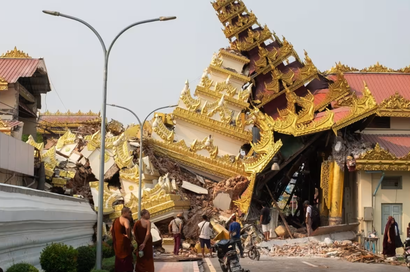
Ho-him, C. and Walker, O. (2025). Death toll passes 1,600 after devastating earthquake in Myanmar. [online] @FinancialTimes. Available at: https://www.ft.com/content/d2bfe23b-5efd-46aa-89dc-cf099b3293fb [Accessed 15 May 2025].
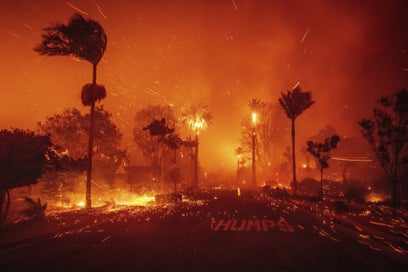
(2025). Palisades Fire Destroys 1,1000 Structures, 5 Dead as LA Engulfed by 5 ... [online] Available at: https://sl.bing.net/iyrmOnSvh7I [Accessed 15 May 2025].
On the left, there is a picture depicting the Myanmar Earthquake which was a magnitude 7.7 earthquake that struck central Myanmar on the 28th March 2025, causing widespread devastation and loss of life. As we know, more than 3,000 people have died and 4,500 people have been injured.
On the right there is a picture depicting the LA Wildfires when the Santa Ana wind event brought extreme winds to Southern California beginning on the 7th January 2025, causing multiple fires to spread rapidly throughout the Greater Los Angeles area, destroying thousands of structures and burning over 50,000 acres and even taking the lives of at least 30 people.
Both of these events lasted weeks and both of these events were broadcasted daily on UK news platforms. It was because of these events that sparked my interest in creating a documentary about natural disasters. And within these articles about these events, we can see the victims it affected and how their lives changed but there is little to no talk about the first-responders that each individually were supporting people and some who list their own lives fighting for people. During the 9/11 travesty that took place in 2001, the world truly united with our first responders and got a close look into how this event affected them. But alongside this, our first-responders do so much and see/experience so much on a daily basis that there is a gap of coverage in the media. This is where I think the marketing for my product right now is the perfect opportunity to take on this perspective, especially s we enter summer for wildfire and flood season.
Overall this research impacts my FEP as it really shows the contrast in coverage of these events and how in-demand my idea is in today's society. Doing this research allows me to see where the most interest in my audience peaks and understand what I can discuss more of to reach top engagement for my product.

Create Your Own Website With Webador